Disclosure: This post may contain affiliate links. I may earn a small commission for my endorsement, recommendation, testimonial, and/or link to any products or services from this website.
This is the easy cranberry walnut no knead bread recipe for non-bakers! With just 6 basic ingredients and about 5 minutes of prep, you can whip up a loaf of bakery-style crusty homemade bread. Thanks to the magic of a Dutch oven, the outside gets perfectly browned and chewy, while the crumb stays light and fluffy. You’ll love the added crunch from the buttery walnuts, as well as the sweet, tart cranberries throughout. It’s perfect as a side dish with dinner, for sandwiches at lunch, or toasted for breakfast!
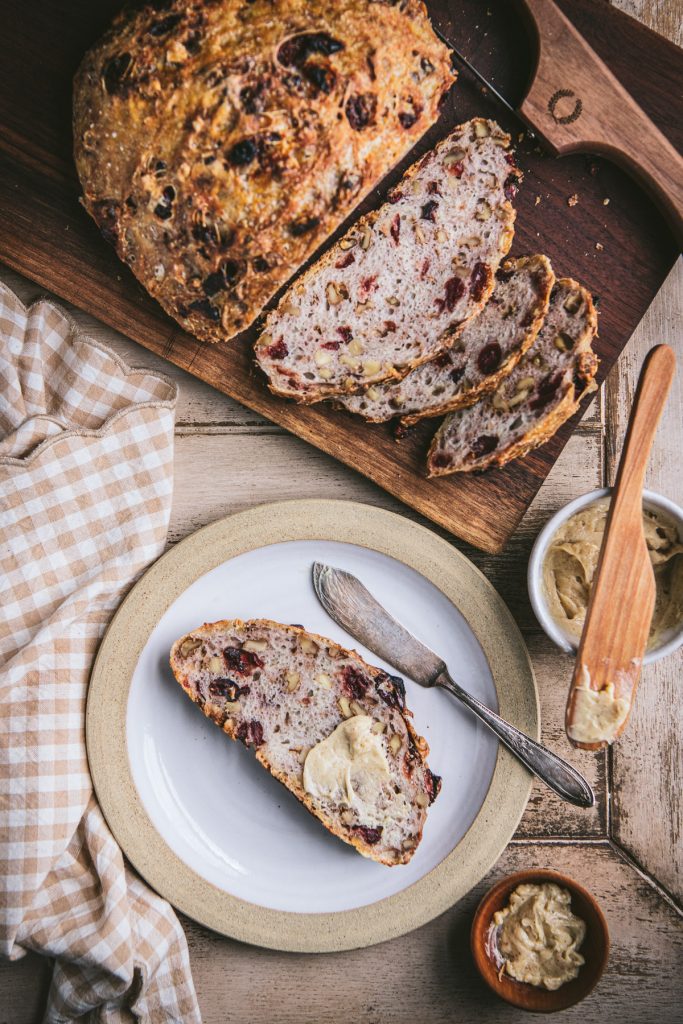
No Knead Bread Recipe
It’s hard to beat the aroma and taste of freshly-baked homemade bread! If homemade dough sounds intimidating or time consuming, then you have come to the right place. You don’t need to nurture a sourdough starter for this perfect, crusty loaf! While my cranberry walnut no-knead bread recipe might be incredibly simple, the end result is better than most artisan breads that I’ve bought at the farmer’s market or bakery. Grab your Dutch oven, let the dough rest overnight, and you’ll soon see that you’re not sacrificing taste or texture with this particular method!
I’ve slightly adapted the no-knead bread recipe that I originally found in Ruth Reichl’s book, My Kitchen Year, and also added cranberries and walnuts for a delicious twist. Ruth adapted her recipe from Jim Lahey’s popular no knead bread recipe that was published in the New York Times many years ago. You can find countless variations on the internet, but this is the no-fail method that I have landed on for a perfect loaf every time!
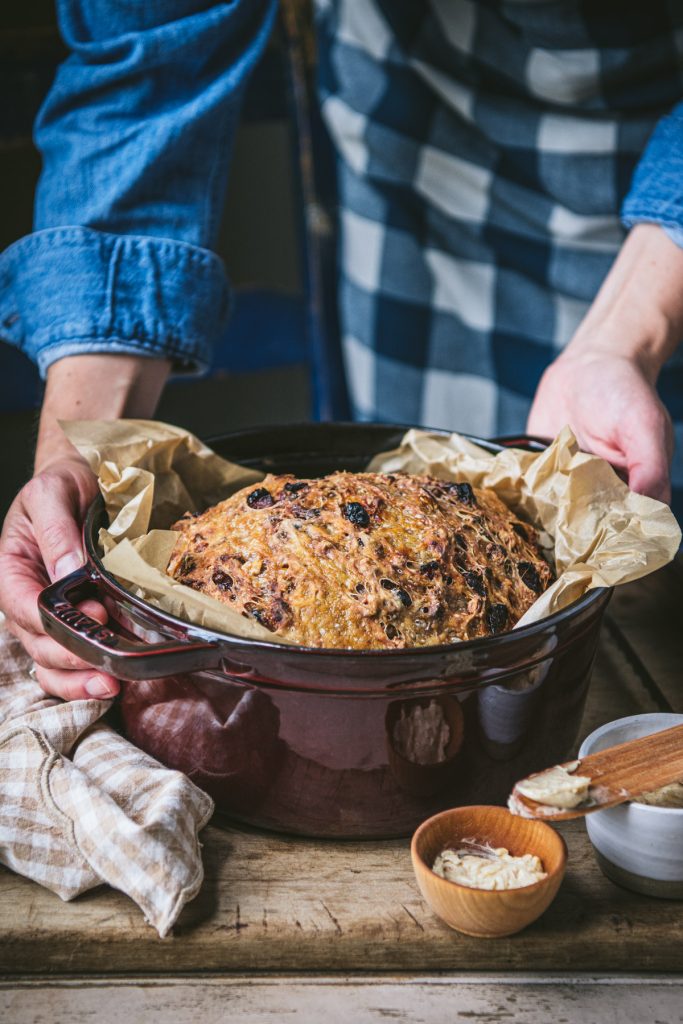
What is the point of no-knead bread?
Traditionally, we knead bread dough in order to form gluten. Gluten is a combination of water with two proteins found in wheat flour (glutenin and gliadin). Folding, stretching, and kneading the dough develops various connections between the proteins. The more you knead the flour, the more gluten develops. Well-developed gluten allows the yeasted dough to stretch and expand as it rises. Proper kneading also produces a finer grain or texture in breads.
With that said, you’re probably wondering how it’s possible to bake a loaf of bread without kneading! The difference is that a no-knead bread recipe creates a very wet dough. This wet dough allows the glutenin and gliadin proteins to float around on their own, therefore forming gluten on their own, and thus eliminating “the need for kneading!” This saves you a lot of effort by substituting time in place of effort. A no-knead bread recipe is much less effort than a traditional loaf of bread, but you have to allow plenty of time for the dough to develop.
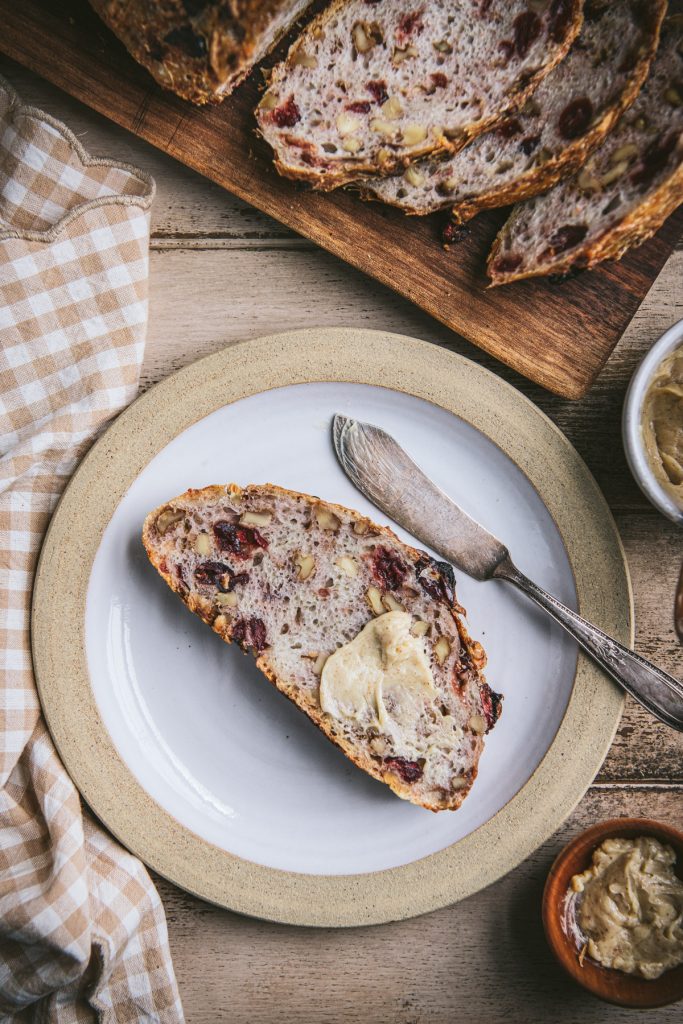
How long can you let no-knead bread rise?
This dough is pretty forgiving, so you can let it rise for a couple of days, if you prefer. In her book, Ruth Reichl actually recommends punching the dough down in the bowl and then letting it rise again two, three, or even four more times. It will require less time to double in size with each additional rising. While this may yield an even better result, I don’t have the patience for that kind of time commitment, and I don’t think it’s necessary for a delicious loaf of bread. Just remember that the 18-hour recommended timeframe is flexible, and you can adjust this to suit your particular schedule. As much as a few days, or as little as 12 hours, will still yield a flavorful loaf!
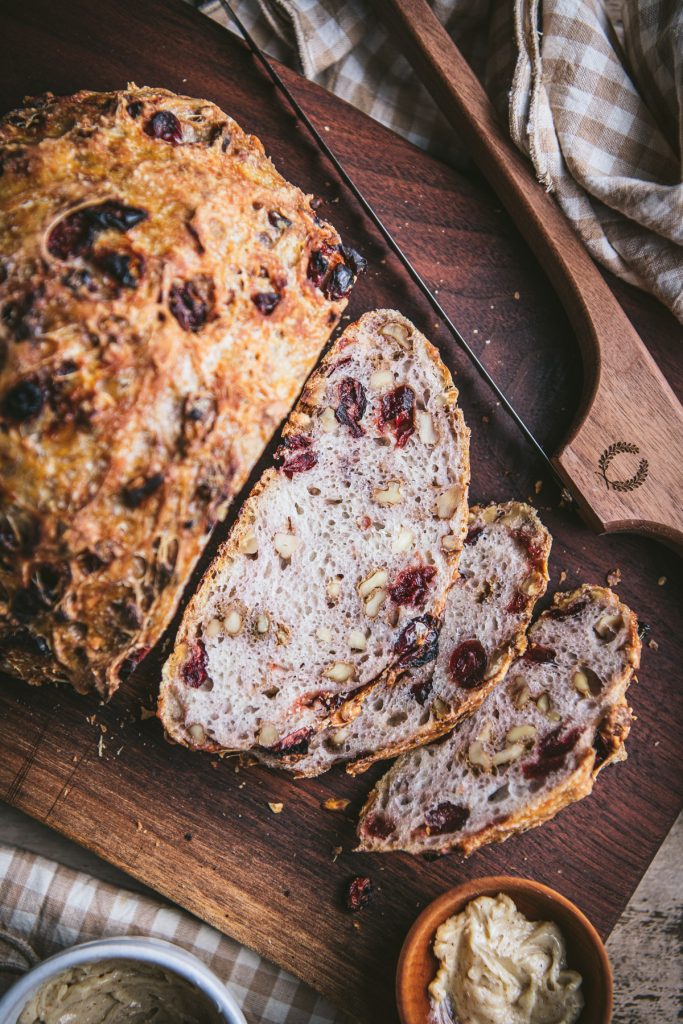
Is no-knead bread better than knead bread?
Most folks agree soaking the wheat in the wet dough overnight results in extra flavor. Not only is no knead bread good, but you might just find that it’s the best bread you’ve ever tasted! It reminds me of a classic French baguette with that super crispy crust and chewy, soft inside. It’s perfect for ripping off a hunk and dunking in soup, toasting, or slathering with butter and jam.
What happens if you knead no knead bread?
There’s no harm in doing so. The long rising time helps to develop the gluten in the dough and gives the bread more flavor, but kneading the dough by hand may develop the gluten quicker so that you can bake it sooner.
Ingredients
This is just a quick overview of the very simple ingredients that you’ll need for a loaf of Dutch oven cranberry walnut bread. As always, specific measurements and step-by-step instructions are included in the printable recipe box at the bottom of the post.
- Bread flour: all-purpose flour has between 8 and 11 percent protein, while bread flour contains between 12 and 14 percent protein. The extra protein in bread flour results in a slightly higher rise. I highly recommend using bread flour in this recipe; however, if you’re in a pinch and you only have all-purpose flour, the recipe will work with the all-purpose flour, too.
- Salt: for flavor. I use regular table salt here rather than kosher salt.
- Instant yeast: this recipe calls for instant (or rapid-rise) yeast, which you can add directly to your dough. By contrast, active dry yeast must be dissolved in warm water (“proofed”) before combining with other ingredients. I have only used instant yeast for testing this recipe; however, Cook’s Illustrated has a great article with instructions on how to substitute active dry for instant (or rapid rise) yeast, if necessary.
- Sweetened dried cranberries: a nice sweet, chewy, and slightly tart addition to the dough. I use Craisins brand.
- Walnuts: these nuts pair well with the cranberries and add great crunchy texture throughout the bread. You can substitute with chopped almonds, pecans, hazelnuts, or other nuts of your choice.
- Warm water: to activate the yeast. Make sure that it’s not too hot and not too cool — somewhere in the range of about 110˚-115˚F is ideal.
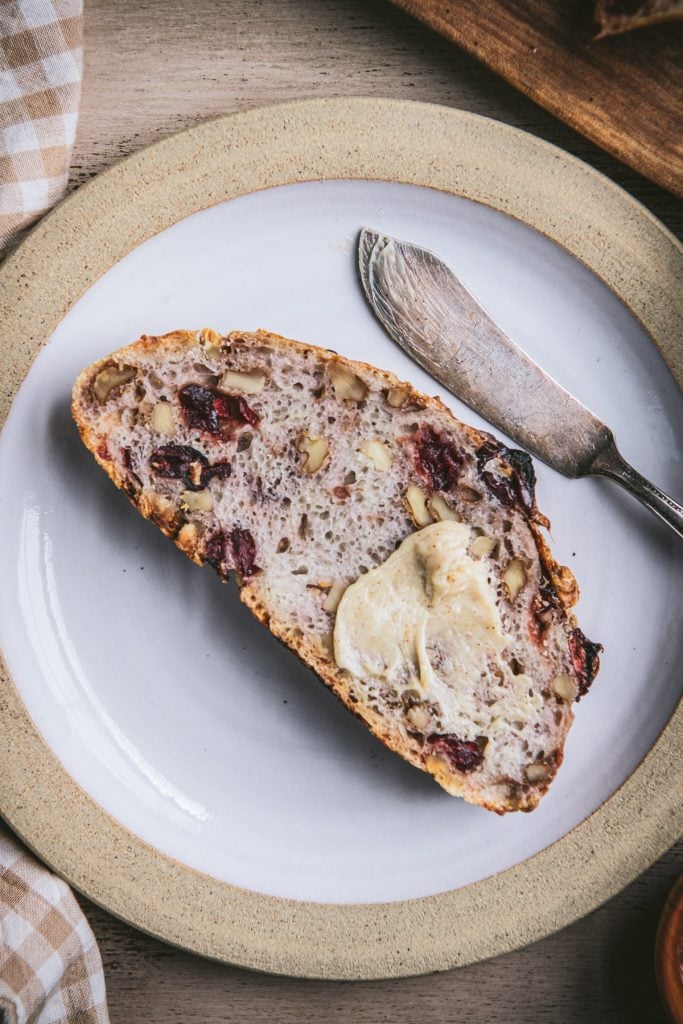
Why You Need a Dutch Oven for this No Knead Bread
The cast iron Dutch oven is an essential tool for creating a loaf of crispy, crusty, golden, artisan-style bread. When unbaked dough, with all of its interior moisture, is put inside the hot pot, humidity is captured in the form of steam. The steam gets trapped inside with the Dutch oven’s tight-fitting lid, which keeps the crust soft longer, so it can continue to expand during the early stages of baking. Additionally, the steam hitting the bread’s surface gelatinizes some of the starches there, which swell and become glossy, creating a crust with subtle luster. The end result is a loaf of artisan bread with a crackly crust and a glossy surface that’s beautifully blistered with bubbles.
The steam created in the Dutch oven also yields a better-tasting loaf of bread. The moisture in the pot keeps the surface of the dough cool for a longer amount of time as the loaf bakes, which allows enzymes (from the yeast) to continue reducing the starches in the flour to simple sugars. These sugars caramelize and create the golden crust and irresistible flavor of a perfectly baked loaf of bread.
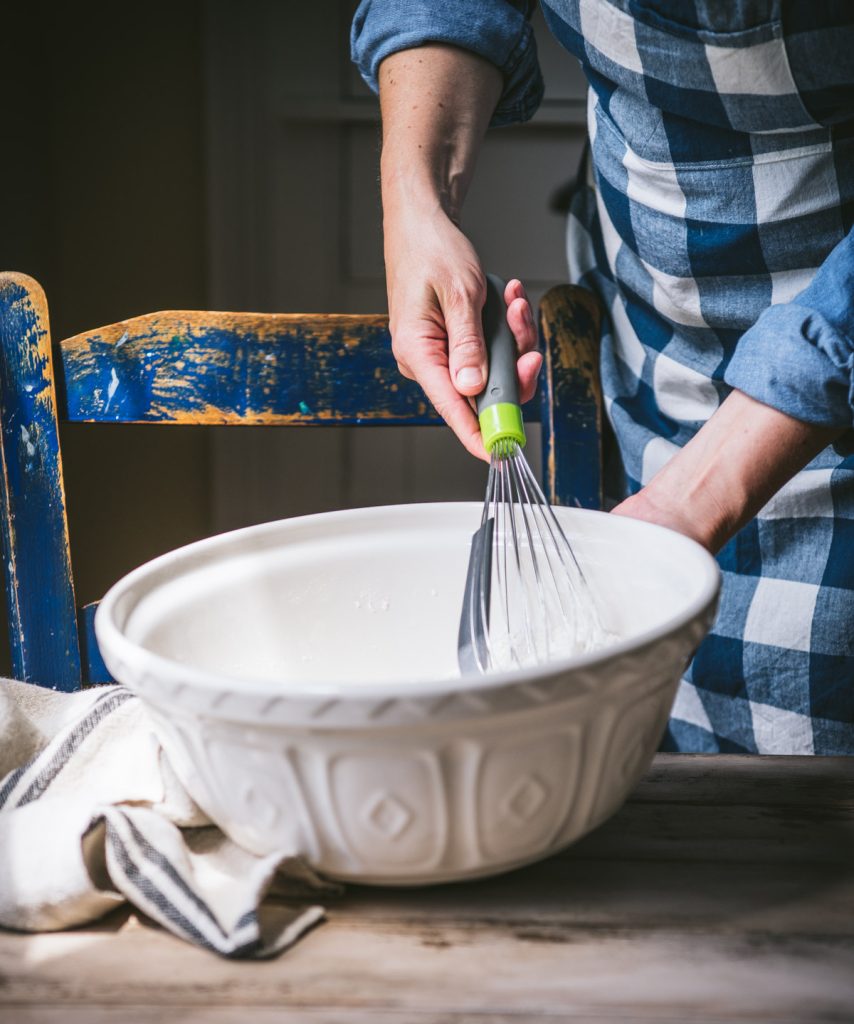
What type of Dutch oven is best for baking bread?
An enameled cast iron Dutch oven is my top choice for baking a loaf of bread. The heavy-duty pots distribute heat evenly and have a tight-fitting lid that efficiently traps the steam. You’ll need a 4 – 6-quart Dutch oven for this recipe. I love the 4-quart Staub Dutch oven or the 5 ½ -quart Le Creuset Dutch oven, which are heirloom pieces of cookware that will last you a lifetime. Le Creuset now offers a cast iron bread baker that’s specifically designed for Dutch oven bread recipes, too! For a more budget-friendly option, the Lodge Enameled Cast Iron Dutch oven also has a good reputation.
I’ve tested this recipe in a larger 6-quart pot and in the smaller 4-quart pot, and I find that the smaller Dutch oven yields a higher, rounder loaf. The larger Dutch ovens have a larger surface area, which allows the wet dough to spread more in the pot, so the loaf is wider, but not as tall. It will still taste good, but the loaf will have a different shape.
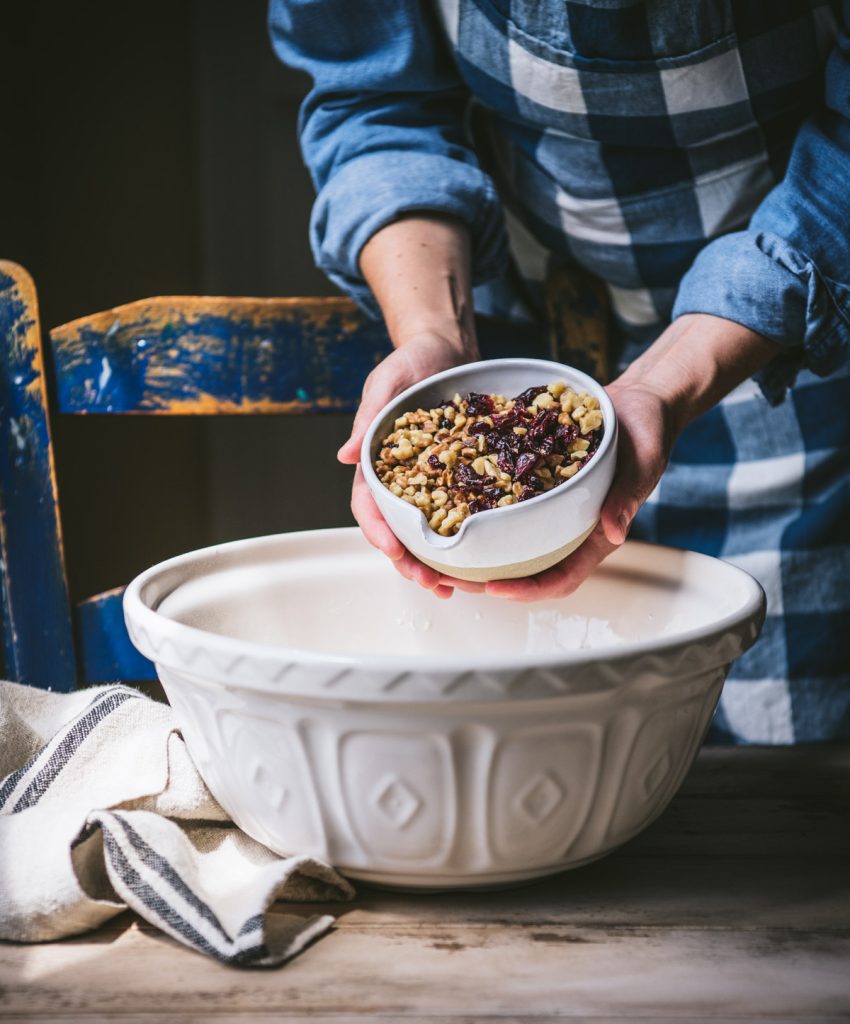
Do I need to preheat the Dutch oven for bread?
Yes! While your dough is rising for the second time, you’ll need to place the Dutch oven (with the lid on) in a cold oven. Preheat the oven to 475°F while the pot is inside. You want the Dutch oven incredibly hot when you add the dough, since the heat of the cast-iron pot reacts with the wet dough to create the steam that’s essential for a good loaf of no-knead bread.
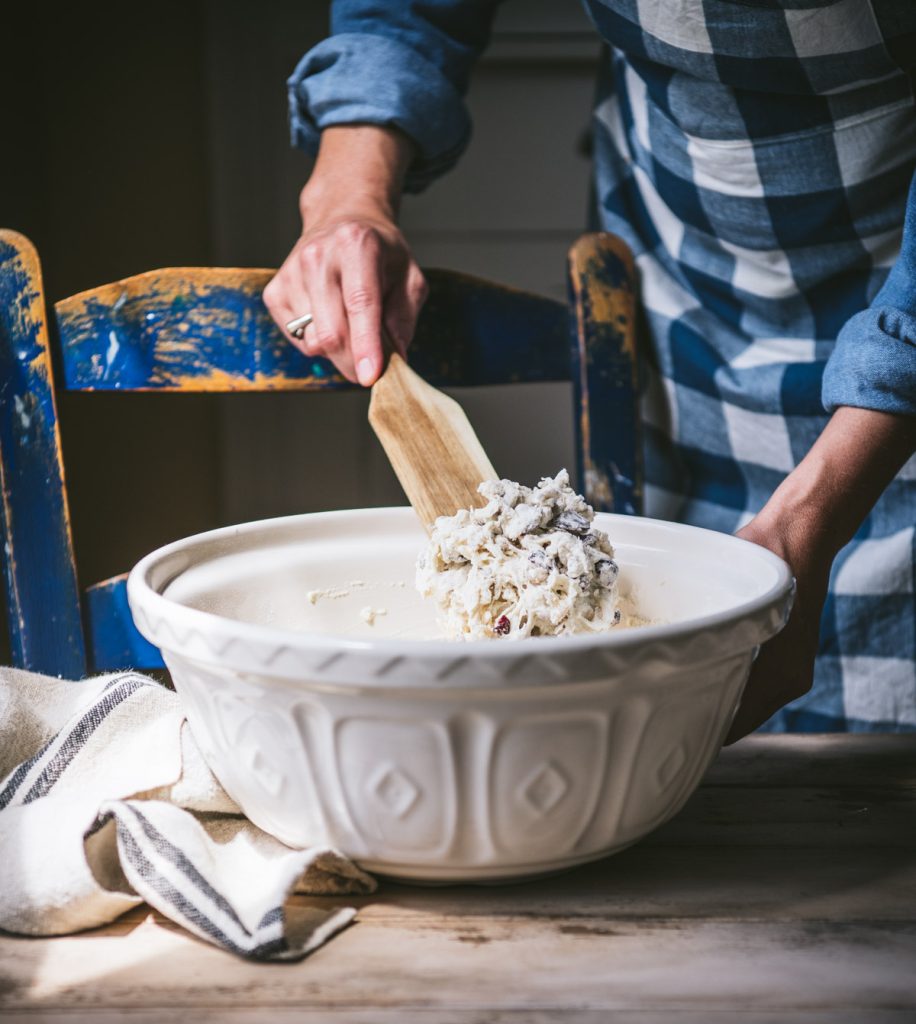
How to Make No Knead Bread
Unlike a more challenging sourdough bread, there’s nothing difficult about this recipe. The hardest part is just being patient and giving it time to rise! There’s only about 5 minutes of actual hands-on time necessary (no stand mixer required), and the rest of your bread baking experience will be spent waiting for the dough to develop, bake, and cool. Don’t be intimidated, because this loaf is practically impossible to mess up!
- Combine flour, salt, and yeast in a large bowl.
- Stir in the cranberries and walnuts.
- Add the water and stir with a wooden spoon until the dough comes together and you don’t see any more dry pockets of flour.
- Cover the large mixing bowl with plastic wrap or a cotton towel and leave the dough to rise at room temperature for about 18 hours.
- Transfer the dough to a piece of parchment paper on the counter. Shape into a loose ball, cover with a fresh piece of plastic wrap, and let rise for 30-60 more minutes while you preheat the oven.
- Place the Dutch oven in a cold oven. Preheat the oven and the Dutch oven to 475°F.
- Carefully lift the parchment paper (with the dough on it) and place the parchment paper and dough into the hot Dutch oven.
- Cover with the lid and bake for 30 minutes.
- Remove the lid. Bake for 10-15 more minutes.
- Transfer to a wire cooling rack. Let the bread cool and rest for at least 1 hour before slicing with a serrated sharp knife.
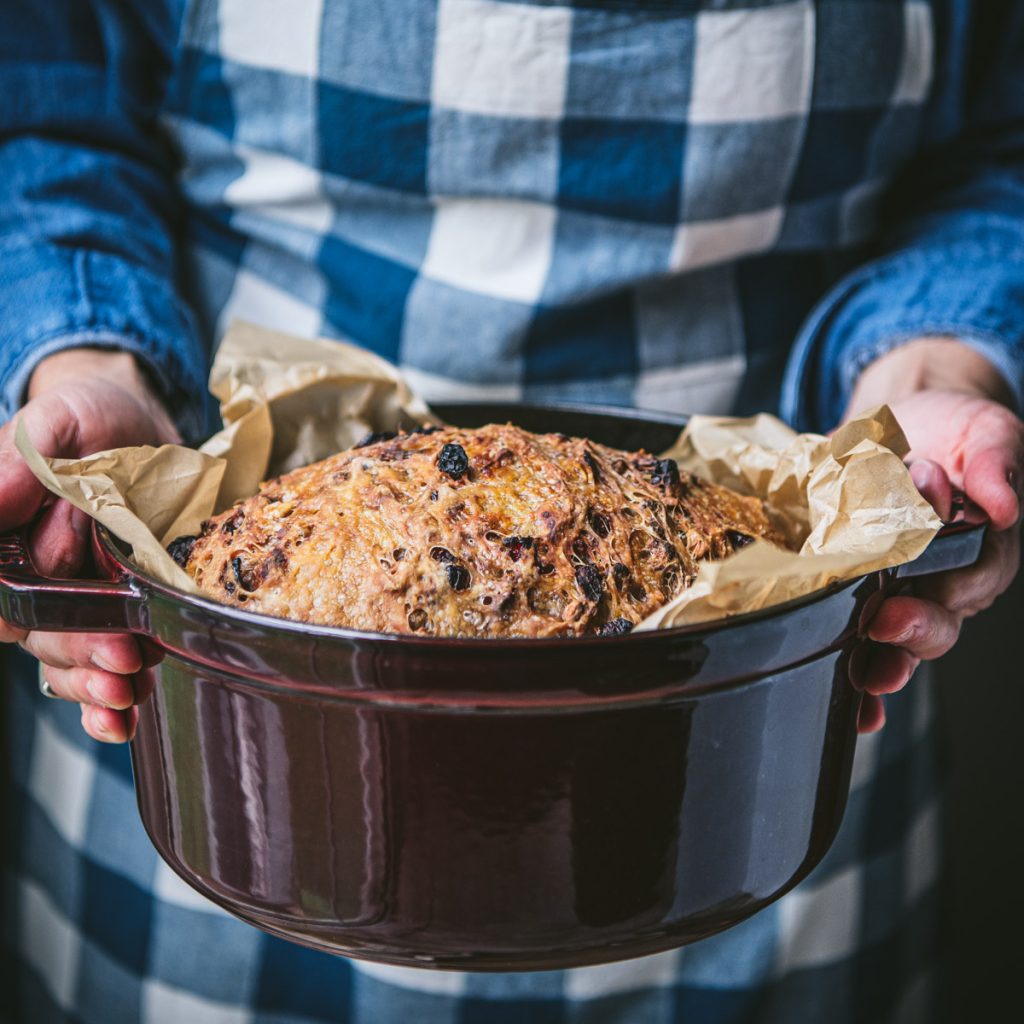
Serving Suggestions
This hearty, rustic bread is delicious at any time of day! We love it for breakfast when toasted with butter or pumpkin spice sorghum butter (shown here). You can also use the bread to make sandwiches for lunch. Try it with turkey and cranberry sauce (i.e., Thanksgiving leftovers), ham, grilled chicken, this easy chicken salad, or spread with Southern pimento cheese.
As a side dish, the bread goes well with any of these dinner entrées:
- Chili (like this Slow Cooker Chili, Beef and Beer Chili, White Bean Chicken Chili, Pumpkin Chili or Classic Beef Chili)
- Soup (such as Chicken Tortilla Soup, Chicken Vegetable Soup, Split Pea Soup, Hamburger Soup, or Creamy Cauliflower Soup)
- Stew (like this Crock Pot Brunswick Stew, Chicken Stew, Coq au Vin, or Dutch Oven Beef Stew)
- Beans (such as Lima Beans, Black-Eyed Peas, Appalachian Soup Beans, Beans and Greens, Ranch Style Beans, or Baked Beans)
- Barbecue (like Crock Pot Beef Barbacoa, Baby Back Ribs, Pulled BBQ Chicken, Pulled Pork, or Dr. Pepper Pulled Pork)
- Seafood ( such as Shrimp and Grits, Crab Cakes, and Shrimp Creole)
- Fried Favorites (such as Fried Chicken, Fried Catfish, Oven-Fried Fish, Fried Oysters, or Fried Shrimp)
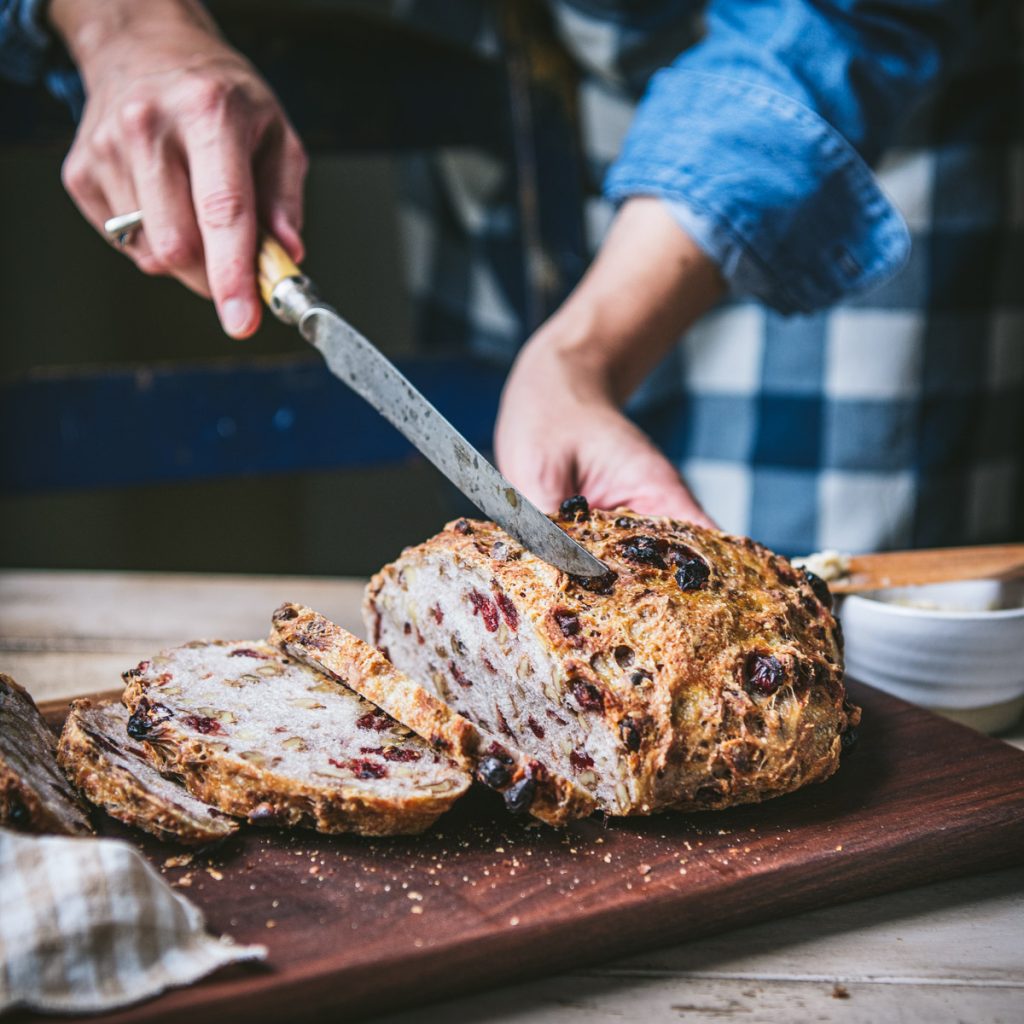
Storage
Dutch oven bread recipes are called “lean breads” because they do not include any added fat to keep them soft and moist. As a result, they dry out quickly and are best enjoyed on the same day that they’re baked. You can store the loaf of bread wrapped tightly in plastic at room temperature for 1-2 days, but the crust will be less crispy. To keep the crust crispy, store the bread in an open paper bag at room temperature. Day-old bread is delicious when toasted for breakfast!
To extend the life of your bread, you can wrap the loaf tightly and freeze for up to 2 months.
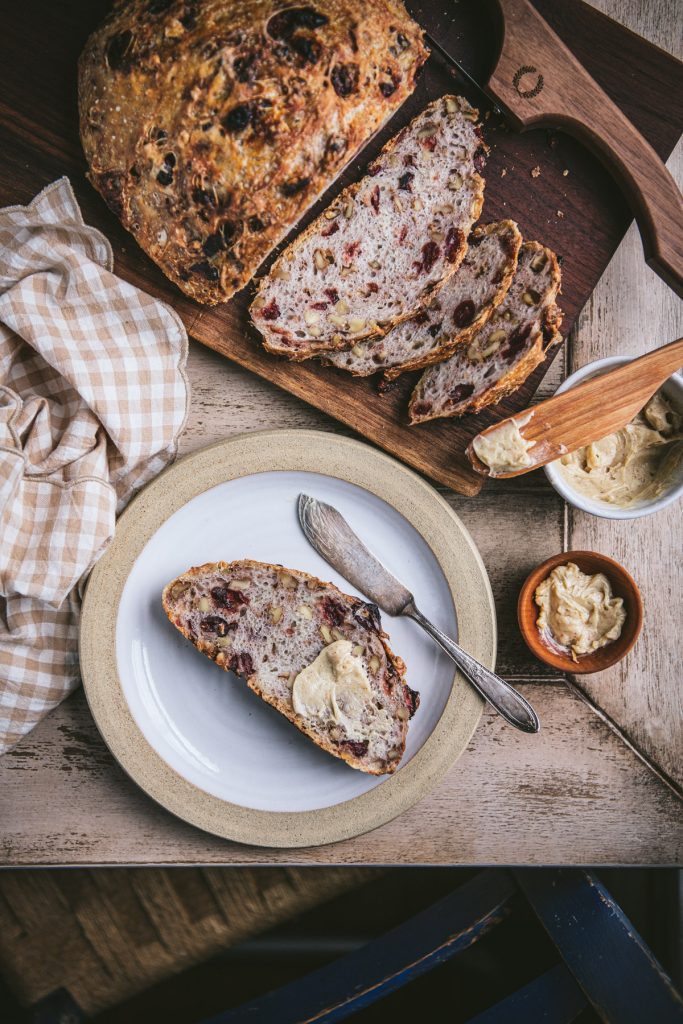
How to Freeze the Dough
Prepare the dough as instructed and let it rise for 18 hours. Form the dough into a loose ball, wrap it in plastic wrap, and place the dough in a freezer-friendly container. Freeze the dough for up to 2 months. When ready to bake, allow the dough to come to room temperature for 2-3 hours on the counter, and then bake as directed.
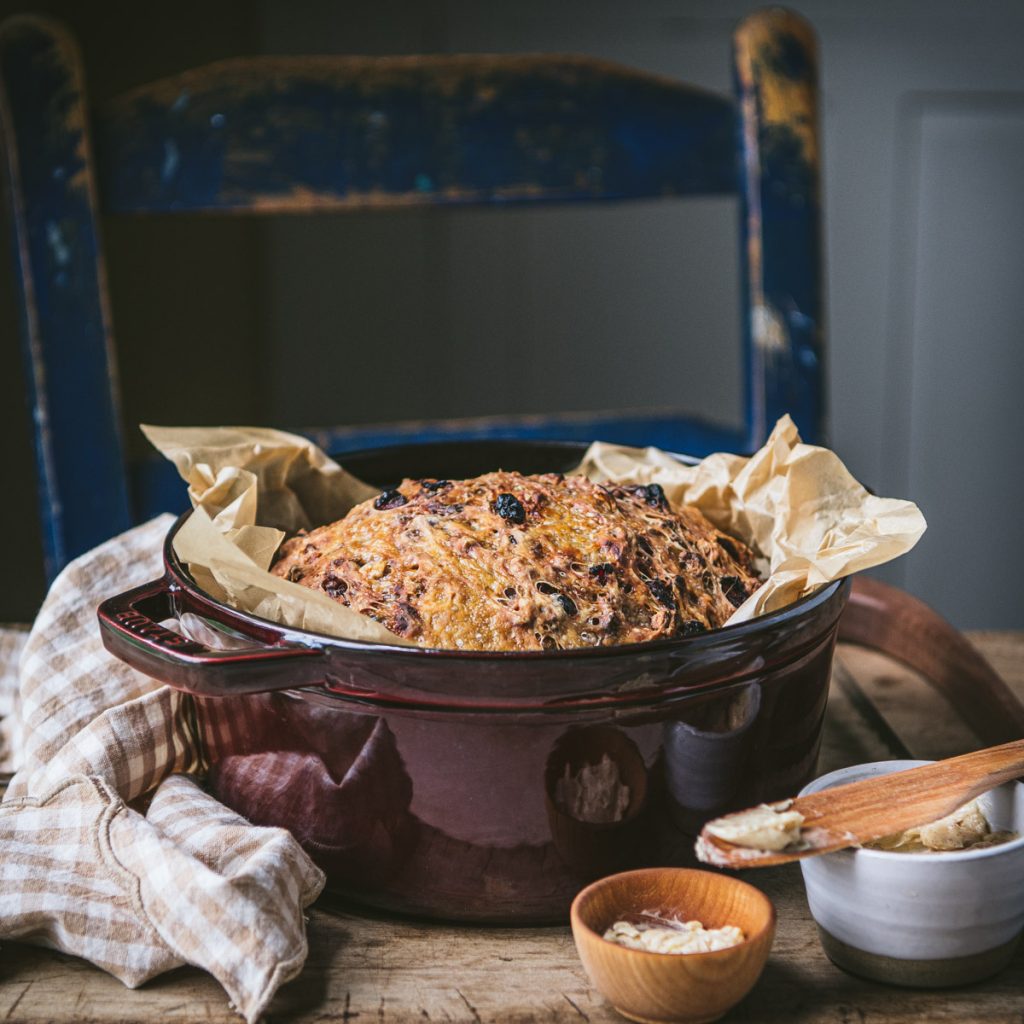
Recipe Variations
- Don’t have time to let the dough rest for a full 18 hours? The bread will still be delicious if you only let it rest for up to 10-12 hours. Just remember that more flavor develops the longer it sits.
- Bread flour yields the best texture; however, you can substitute with all-purpose flour in a pinch.
- This recipe calls for instant (or rapid-rise) yeast, which you can add directly to your dough. By contrast, active dry yeast must be dissolved in warm water (“proofed”) before combining with other ingredients. I have only used instant yeast for testing this recipe; however, Cook’s Illustrated has a great article with instructions on how to substitute active dry for instant (or rapid rise) yeast, if necessary.
- Swap out the cranberries for raisins or dried currants. Similarly, you can substitute other nuts (like pecans or almonds) for the walnuts.
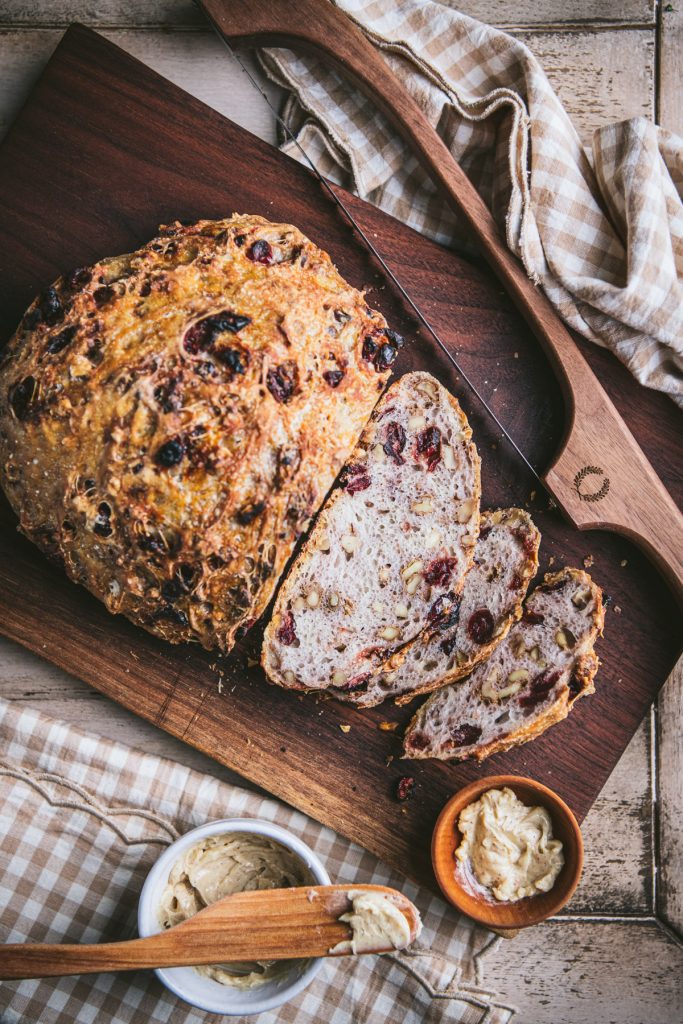
Tips for the Best Dutch Oven Bread Recipe
- Use warm water — not too hot and not too cold. The water should feel like warm bath water (about 110-115°F). If it’s too hot you will kill the yeast; too cool and the yeast will not activate.
- If your no-knead bread does not rise, it could be due to any number of reasons. For instance, your yeast may not be fresh. Even with a good expiration date, yeast has a short shelf life once a package is opened (I recommend keeping it in the freezer). It’s also possible that your water was the wrong temperature (see my note above regarding water temp).
- If the inside of your bread is dense and gummy, this is likely the result of two main culprits. First, the dough may not have rested long enough to give the gluten a chance to fully develop. Alternatively, the bread may not be cooked through all of the way. When the bread comes out of the oven, it’s still “cooking” and steaming. That’s why it’s important to wait and let the bread sit for at least an hour before slicing into it.
- Why is my no-knead bread tough? If the bottom of the bread is too dark or too tough to slice, it may be because the Dutch oven is too close to the heating element. Set the rack at the highest possible position that still allows the Dutch oven to fit. Also, use an oven thermometer to make sure that your oven temperature is properly calibrated. Finally, you might need to preheat the oven to 475°F, but then reduce the oven temperature slightly (to 450°F, for example) when you add the Dutch oven.
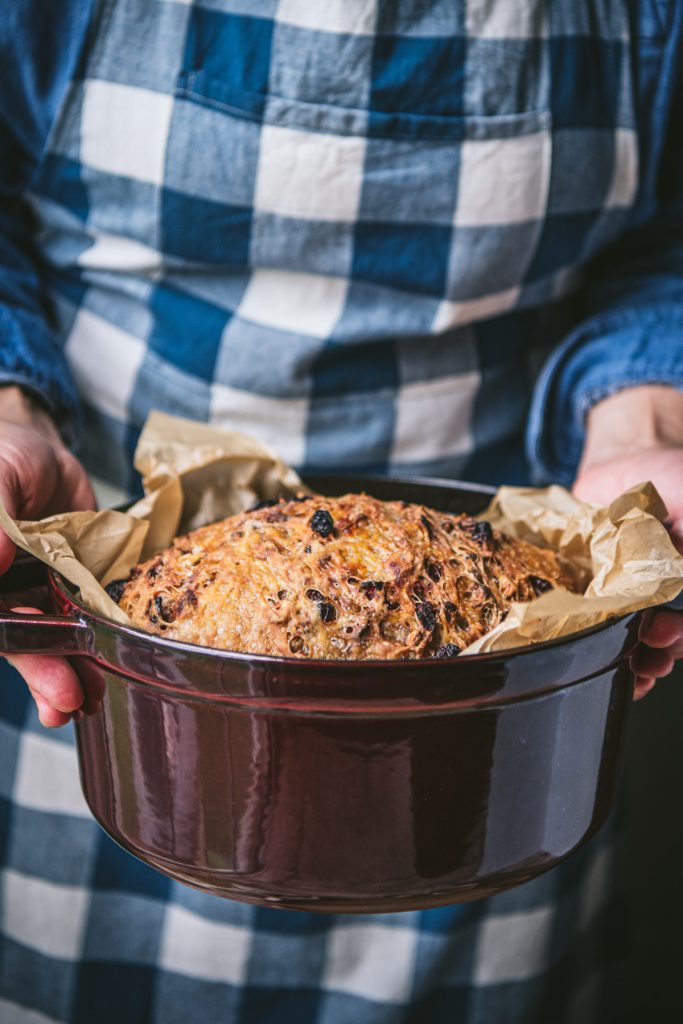
More Homemade Bread Recipes to Try
- Classic No-Knead Bread Recipe
- No-Knead Dutch Oven Bread (with a shorter rise time)
- White Bread with Milk and Honey
- Jalapeno Cheddar Bread
- Classic Farmhouse Oatmeal Bread
- Homemade Breadsticks
- Soft Homemade Dinner Rolls
- Homemade Crescent Rolls {Amish Butterhorns}
- Soft Pretzels {Auntie Anne’s Copycat}
- Quick, No-Knead English Muffin Bread
- Easy French Baguette for Beginners
- Homemade Focaccia Bread
- Beer Bread
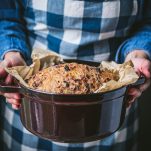
Cranberry Walnut No-Knead Bread
Ingredients
- 3 cups bread flour
- 1 ½ teaspoons salt
- ½ teaspoon instant yeast
- 1 cup sweetened dried cranberries
- 1 cup chopped walnuts
- 1 ⅓ cups warm water (or more as needed)
Instructions
- In a large bowl, whisk together the flour, salt, and yeast.
- Add the cranberries and walnuts; toss to combine.
- Stir in the warm water, adding a little bit more (if necessary) to bring the dough together just until you can’t see any dry pockets of flour.
- Cover the bowl and leave to rise at room temperature for about 18 hours, until the dough has doubled in size. It will spread out in the bowl and look bubbly.
- Place a piece of parchment paper on the counter and dust with flour. Gently nudge the dough from the bowl onto the parchment. Shape the dough into a loose ball by gently folding under the edges.
- Cover the dough with plastic wrap or a towel. Let the dough rest and continue rising for about 30-60 more minutes.
- While the dough rests, place a 4-6-quart cast iron Dutch oven (with the lid on) in the cold oven. Preheat the oven to 475°F.
- Once the dough has rested for 30-60 minutes, carefully remove the hot pot from the oven. Take off the lid. Pick up the parchment paper and gently place the parchment paper (with the dough on it) into the pot.
- Cover the pot and put it back in the oven to bake for 30 minutes.
- After 30 minutes, remove the lid and continue baking for an additional 10-15 minutes (or until the loaf has turned a deep brown color).
- Allow the bread to cool on a rack for at least 1 hour before slicing and serving.
Notes
- Use warm water — not too hot and not too cold. The water should feel like warm bath water (about 110-115°F). If it’s too hot you will kill the yeast; too cool and the yeast will not activate.
- If your no-knead bread does not rise, it could be due to any number of reasons. For instance, your yeast may not be fresh. Even with a good expiration date, yeast has a short shelf life once a package is opened (I recommend keeping it in the freezer). It’s also possible that your water was the wrong temperature (see my note above regarding water temp).
- If the inside of your bread is dense and gummy, this is likely the result of two main culprits. First, the dough may not have rested long enough to give the gluten a chance to fully develop. Alternatively, the bread may not be cooked through all of the way. When the bread comes out of the oven, it’s still “cooking” and steaming. That’s why it’s important to wait and let the bread sit for at least an hour before slicing into it.
- What happens if you knead no knead bread? There’s no harm in doing so. The long rising time helps to develop the gluten in the dough and gives the bread more flavor, but kneading the dough by hand may develop the gluten quicker so that you can bake it sooner.
- Why is my no-knead bread tough? If the bottom of the bread is too dark or too tough to slice, it may be because the Dutch oven is too close to the heating element. Set the rack at the highest possible position that still allows the Dutch oven to fit. Also, use an oven thermometer to make sure that your oven temperature is properly calibrated. Finally, you might need to preheat the oven to 475°F, but then reduce the oven temperature slightly (to 450°F, for example) when you add the Dutch oven.

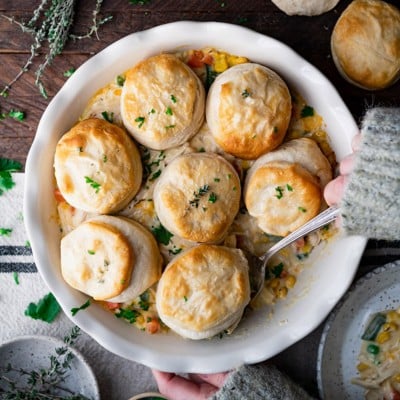
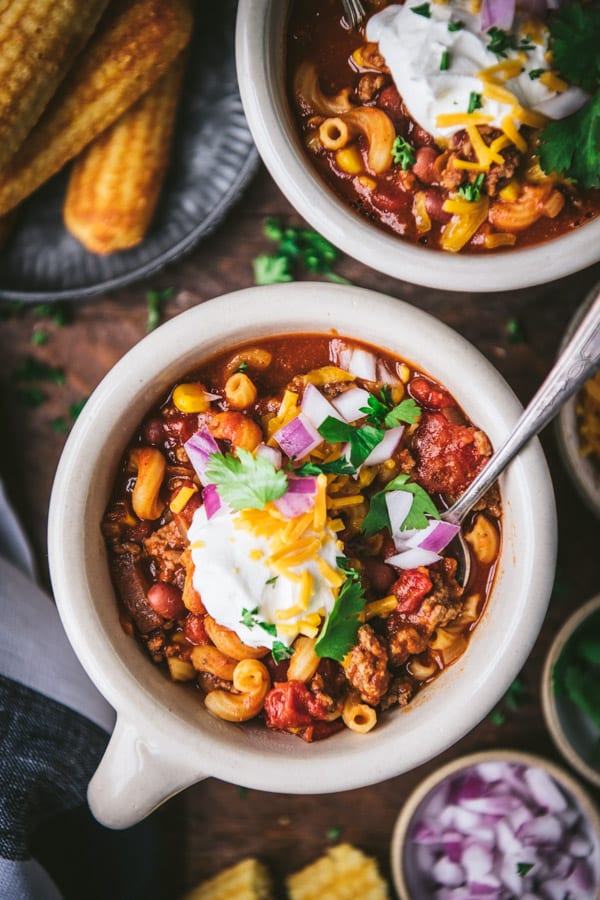
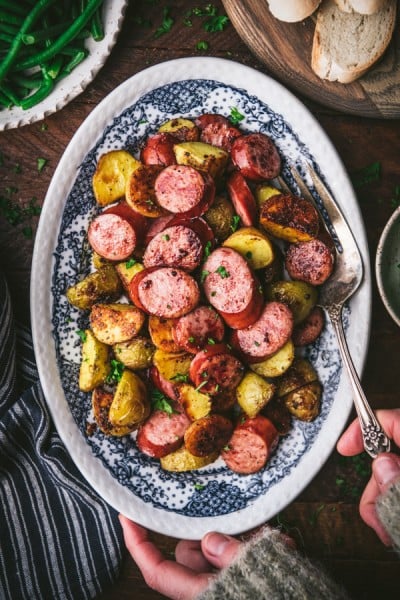








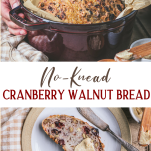
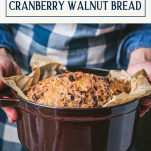
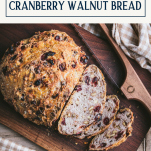
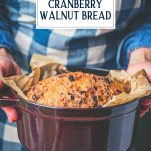
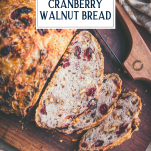
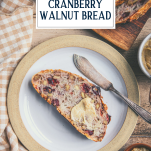
I make no knead bread all the time and it always comes out perfect! Never with cranberries and walnuts.
Guess I know what we’re having with some homemade chicken soup full of vegetables from the garden!
You can’t leave out the honey butter…..
Thank you!!
One more thing….what’s the bread “knife” you’re using?
Hi, Carrie Anne! That bread bow is from Farmhouse Pottery. Love it! Here’s the link: https://www.farmhousepottery.com/products/pantry-bread-bows?variant=9970774442020
Thank you!!
Hi Blair, I really want to make this, I’m a new bread baker. I need two loaves though. Is it best to make the dough twice or double the recipe and split it in half before rising?
Thanks! Looking forward to this…
Hi, Lisa! I think it would be easiest to prepare two separate batches of the dough in two separate bowls.
Hope you enjoy!
Sounds like the perfect meal! Glad you’ll give this version a try.
Hi Blair,
I want to make a couple of loaves of this bread, but I have only one Dutch oven. Do you think I would need to let the Dutch oven completely cool after baking one loaf before baking another one? Any suggestions you have are most welcome!
Deb
Hi, Deb! No, you definitely don’t need to let the Dutch oven cool in between loaves. In fact, you’ll want to give it plenty of time to heat up in the oven before adding each loaf of bread. You want the Dutch oven incredibly hot when you add the dough, since the heat of the cast-iron pot reacts with the wet dough to create the steam that’s essential for a good loaf of no-knead bread. Hope that helps, and enjoy!
Something is not working for me. Second try and very little rise in the bread. Yeast 1/2 of tablespoons (instant) made sure temperature of water was 104. Hope for some suggestions.
Hi, Juana! It’s tough to know for sure without being in your kitchen with you. If your no-knead bread does not rise, it could be due to any number of reasons. For instance, your yeast may not be fresh. Even with a good expiration date, yeast has a short shelf life once a package is opened (I recommend keeping it in the freezer). Also, maybe the water should be a bit warmer? I recommend 110-115°F to activate the yeast. Those are just the first couple of suggestions that come to mind.
Should add more yeast, but flavor was great! Just what I expected and wanted, not too sweet and crunchy crust.
Thanks, Jackie! You can definitely add more yeast. I’ve tested it with additional yeast and didn’t notice a difference in the size of the loaf, but feel free to experiment on your own. 🙂
Complete novice bread maker. Followed the directions exactly except I split the dough and froze half for later as it is only my husband and me. I baked it in my 2.75 quart Staub. It is the best walnut and cranberry bread I have ever eaten! Thank you for making the directions so clear and easy to follow.
Thank you so much, Tish! We’re so happy to hear it turned out well.
Will this bread rise faster if I use more yeast? I have only made no knead bread with one other recipe that uses the whole envelope, and it had a 2 – 3 hour rise time. Just curious? Thanks.
Hi, Doris! I don’t think so. This type of bread develops its flavor and texture over the long rise time, so I wouldn’t try to shorten that step with more yeast. 🙂
Hallo,
ich besitze keinen Dutch Ofen. Kann ich das Brot auch in einem normalen Ofen und Backform backen?
Es würde mich reizen, es auszuprobieren.
Danke schon einmal für eine Antwort.
LG. Elli
Hallo! Ein Schmortopf in der Größe eines Schmortopfs mit schwerem Boden und dicht schließendem Deckel könnte hierfür geeignet sein, aber ich habe ihn nicht getestet und kann Ihre Ergebnisse nicht garantieren. Ein holländischer Ofen ist wirklich das beste Gerät, um sicherzustellen, dass Ihr Brot gut gelingt, und meiner Meinung nach ist die Investition absolut wert! Günstigere Exemplare finden Sie bei Amazon. Hoffentlich hilft das!
Danke für die Antwort. Ich werde das testen.
LG. Elli